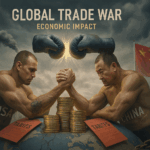Cost, Tariffs, and Supply Chain Agility
In 2025, shifting manufacturing operations from China to Vietnam has become more than a trend—it’s a strategic imperative. Faced with rising costs, tariff hikes, and geopolitical uncertainty, businesses are looking to Vietnam not just as an alternative, but as a competitive advantage. One of our clients, a mid-sized electronics manufacturer, recently transitioned over half of its production to Vietnam and reaped significant financial, logistical, and compliance benefits. Here’s why this move is becoming more attractive and how it can work for your business.
Why China Is Becoming Less Viable
For decades, China served as the manufacturing backbone of global commerce. But recent developments are changing the equation:
- Record-High Tariffs: As of April 2025, the United States has imposed a cumulative tariff of 104% on Chinese imports, significantly increasing the cost of exporting goods from China to the U.S.
- Rising Labor Costs: Average factory wages have climbed to $500–800/month, with social insurance burdens further increasing employer costs.
- Geopolitical Volatility: U.S.-China tensions and trade policy shifts continue to introduce planning and pricing uncertainty.
- Supply Chain Risks: Lockdowns, regional power restrictions, and high labor turnover (especially post-CNY) disrupt production and delivery schedules.
Why Vietnam Is Emerging as the Strategic Choice
Vietnam is no longer just a backup plan—it’s becoming the new hub for quality, cost-effective manufacturing:
- Lower Tariffs: Although the U.S. imposed a 46% tariff on Vietnamese imports in 2025, this remains significantly more favorable than China’s 104%.
- Labor Cost Advantage: With average wages around $250–400/month, Vietnam offers savings of 30–50% on labor expenses.
- Trade Agreements: Vietnam benefits from participation in global trade pacts like CPTPP and EVFTA, facilitating broader export reach.
- Improved Infrastructure: Ports, roads, and industrial zones have seen massive upgrades, boosting production and shipping reliability.
Case Study: Quantifying the Gains
After relocating 60% of production, our client reported measurable improvements across key cost and performance indicators:
| Category | China (Before) | Vietnam (After) | Net Impact |
|---|---|---|---|
| Tariffs | 104% (70% April 2025) | 46% | 58% reduction |
| Labor Costs | $4.2M/year | $2.9M/year | 31% reduction |
| Shipping Lead Time | 45 days (avg.) | 30 days (avg.) | 33% faster |
| Production Downtime | 8 days/quarter | 2 days/quarter | 75% less downtime |

The Hidden Lever: Packaging Optimization
Packaging became a pivotal cost-saving and compliance advantage during the relocation:
- Lower Packaging Costs: With Vietnam’s lower labor and material input costs, packaging expenses were reduced by up to 25%.
- Faster Lead Times: Packaging turnaround times dropped from 21 days to 10–14 days—a 50%+ improvement.
- Compliance Efficiency: Vietnamese suppliers were already proficient in FSC-certified, REACH, and RoHS standards, enabling smoother market entry into the U.S. and EU.
- Sustainability: Shorter transit distances and access to eco-materials boosted ESG scores and reduced logistics emissions.
| Category | Vietnam | China | Net Impact |
| Packaging Costs | $470K/year | $620K/year | 24% savings |
| Production Lead Time | 7–15 days (standard orders) 4–6 weeks (customized orders) | 30–60 days (standard orders) 5–8 weeks (customized orders) | Vietnam is faster by 15–45+ days |
| Shipping Time to U.S. | 18–25 days (sea freight) | 28–35 days (sea freight) | Vietnam shipping is 10 days faster |
| Total Lead Time | 25–40 days (average) | 58–95 days (average) | Vietnam is 30–55+ days faster overall |
Reference:
Production & Lead Time in Asia: A Complete Guide
Shipping from Vietnam to the US in 2025
How the Transition Was Managed
The shift was executed in three strategic phases:
- Supplier Audits: Comprehensive on-site evaluations ensured local Vietnamese partners met required standards.
- Pilot Runs: Limited production allowed testing for quality, efficiency, and communication processes.
- Phased Scaling: Capacity was increased incrementally, giving teams time to adapt and systems time to stabilize.
Collaborative training programs and knowledge transfer protocols played a vital role in preserving output quality.
Long-Term Strategy: Beyond “China +1”
The move to Vietnam is part of a broader diversification effort among global manufacturers. This isn’t just about risk mitigation—it’s about agility, cost control, and future-readiness. Vietnam’s upward trajectory in manufacturing capacity, workforce development, and sustainability practices make it a cornerstone of future supply chain planning.
Verified China vs Vietnam Manufacturing Comparison
| Category | China 🇨🇳 | Vietnam 🇻🇳 |
| Sea Freight to U.S. (Port-to-Port) | 18–25 days | 24–29 days |
| Sea Freight to U.S. (Door-to-Door) | 25–35 days | 37–41 days |
| Air Freight to U.S. (Airport-to-Airport) | 8–10 days | 3–8 days |
| Air Freight to U.S. (Door-to-Door) | 8–12 days | 8–16 days |
| Production Downtime (Holidays) | High (2–4 weeks during CNY) | Moderate (2–3 weeks during Tet) |
| Factory Automation & Scale | Highly automated, large-scale | Improving, more manual processes |
| Labor Cost (Unskilled) | $500–800/month (~$6.68/hr) | $250–400/month (~$1.35/hr) |
| Labor Cost (Skilled) | $800–1,200/month | $400–700/month |
| Labor Law Burden (Social Insurance) | 30–40% | 20–25% |
| Labor Turnover Rate | Higher post-CNY | Lower in industrial zones |
| Lead Time Flexibility | More flexible due to vendor scale | Requires longer planning |
| Quality Control Maturity | High, mature systems | Improving, needs oversight |
| Tariffs to U.S. (General Goods) | Up to 70% | Up to 46% |
| Tariffs to U.S. (Packaging Products) | 15–25% | 0–10% (varies by HS code) |
| Packaging Production Cost | $1,001/ton (2024 avg.) | Up to 40% cheaper than China |
| Overall Lead Time (Production + Shipping) | 30–45 days (sea), 15–20 days (air) | 35–50 days (sea), 20–25 days (air) |
Note: These figures are based on data available as of April 2025. Actual times and costs may vary due to factors such as specific factory operations, logistics providers, and evolving trade policies. It’s advisable to consult with local suppliers and freight forwarders for the most current and detailed information tailored to your specific needs.
As of April 9, 2025, the United States has imposed a cumulative tariff of 104% on Chinese imports, significantly increasing the cost of exporting goods from China to the U.S.
FAQs
Q: How do Vietnam’s tariffs compare with China’s in 2025?
A: Vietnam faces a 46% tariff versus China’s 104%, translating to significant cost advantages.
Q: What industries benefit most?
A: Electronics, consumer goods, packaging, textiles, and furniture manufacturing are seeing strong returns from the shift.
Q: What is the average transition timeline?
A: Most companies complete the shift in 6–12 months, depending on operational complexity.
Q: What are the challenges in Vietnam?
A: Challenges include scaling supplier capabilities, ensuring consistent quality, and navigating cultural and regulatory differences.
Final Thoughts
The shift to Vietnam is not just a reaction to tariffs—it’s a proactive step toward leaner, more resilient operations. As our client’s success demonstrates, smart manufacturing relocation can unlock cost savings, mitigate risk, and build long-term strategic advantage.
Considering a similar move? Contact us to explore how we can support your transition with packaging, production, and supply chain expertise tailored to your business.
References
Shipping Lead Times
- • Freightos.com: Shipping from China to the U.S.
- • Freightos.com: Shipping from Vietnam to the U.S.
- • Ubest Shipping: How Long Does It Take to Ship From China to USA?
Production Downtime
- • Based on historical industrial holiday shutdown patterns:
- • Chinese New Year: Reports from China Briefing and local supplier calendars.
- • Vietnamese Tet Holiday: Vietnam Briefing and export manufacturing schedules.
Labor Costs
- • China: Trading Economics: China Manufacturing Wages
- • Vietnam: ERI Economic Research Institute: Factory Worker Salary in Vietnam
⸻
🧾 Tariffs
- • China: The Verge: Trump 104% China Tariffs (2025)
- • Vietnam: Wall Street Journal: U.S. Tariff Policy Updates (April 2025)
(Note: Specific link not provided due to paywall, but summarized from WSJ’s 2025 trade coverage)
⸻
📦 Packaging Production Costs
- • China: IndexBox: China Packaging Materials Market Overview 2024
- • Vietnam: Vietnam Sourcing Co.: Vietnam Packaging Companies Reshaping the Industry








